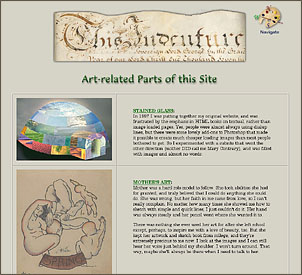A SINGER'S ARTIST HUSBAND.
Julian Story can be classed no longer, if he ever was, among the "unknown husbands of famous wives."
While Mme. Eames-Story has been establishing herself as one of the first singers of her time,
her husband has been advancing no less rapidly in his profession, and Paris and London now regard him as quite or nearly
the best of the younger school of portrait and figure painters. At the Salon of last spring one
of his paintings - a hospital scene, including a large group of portraits -was hung in a place of honor
and was bought by the French government. in London, he has had commissioned from many of the most
prominent people in society and public life. One of his latest orders was for two portraits of the
Prince of Wales, one for William Waldorf Astor, the other for H.R.H. himself. The former is finished, and now hangs
at Cliveden; the second is still on the easel. Lady Wolseley, cardinal Howard, and Mrs. Humphry Ward have also been
among Mr. Story's sitters. Last year he represented American artists upon the jury of the international exhibition in Berlin.
Both Mr. Story and his wife belong to Boston families, though she was born in China and he has passed almost
all his life in Europe. His father was William Wetmore Story, well known as a sculptor and
an author, and his grandfather Justice Story of the United States Supreme Court. As a boy his house
was with his father in Italy, but he went to school and college in England, at Eton and Oxford. Paris is now
his headquarters, he and his wife having built a hosue there; but for the next three years he expects to
spend much of his time in this country, taking a studio in New York.
THE SUCCESSOR OF MILLAIS.
Edward John Poynter, the new president of the Royal Academy, is a refined, able, and scholarly painter whose work is little known
on this side of the Atlantic, and who is never likely to stand, in popular estimation,
with his two predecessors. He was for some years a professor of art at University College, London, and head
of the great training school at South Kensington. He comes of an artistic family, being the son of
a prominent architect, and the grandson of Thomas banks, sculptor and Royal Academician.
Sir Frederic Leighton used to find his duties as president of the Academy exacting enough, but Mr. Poynter combines them with
those of another important office, the directorship of the National gallery. He makes time to paint, too.
APOSTOLIC ART.
Tradition persistently asserts that St. Luke was not only a physician but also an artist. There are in
existence, treausred in remote European monasteries, several ancient pictures whose owners declare them
to be the apostle's work. A traveling American tells of one he saw at Patras, in Greece, where it is preserved in a church dedicated to the Five Wise Virigins.
He was told that in the days of Turkish rule it was buried in the earth, to keep it from the hands of the
Mahometans, the secret of its hiding place being handed down through a line of Christian nuns until Greece was freed.
he could not photograph the painting, as it was covered with a shell of silver, with the exception of two heads - those of the Virgin and
Child; but he found a "wonderful strength and beauty" in the features thus revealed. Unfortunately he neglects
to tell us what medium the artist used, and upon what material he worked.
Information on these points might throw valuable light upon the artistic methods in vogue in the first century -
fourteen hundred years before the accepted date of the invention of oil painting by Van Eyck.
It would be still more valuable, however, if there were any authentic evidence that the picture is as old as
its possessors claim.
CURRENT NOTES OF THE ART WORLD.
James McNeill Whistler is reported to have again established himself in London, from which
city he not long ago departed shaking the dust off his feet and vowing never to return. Mr. Whistler is
probably the most gifted and certainly the most eccentric of
living American artists.
The work of decorating the new national library continues to progress. Conspicuous among the recent additions are William L. Dodge's
large paintings for the ceiling of the western pavillion, which were exhibited in New York on their
way from Paris to Washington. Rowland Hinton Perry, who now occupies Mr. Chase's old New York studio
in West Tenth Street, has completed two of his figures for the fountain.
Miniature painting has become such a fad in London that two associations of its practioners have been formed. By a curious
coincidence, or rather mistake, they took the same title - the Society of Miniature Painters. The younger body
had to change its name to the Society of Miniaturists.











![]() Copyright © 2007, Mary S. Van Deusen
Copyright © 2007, Mary S. Van Deusen